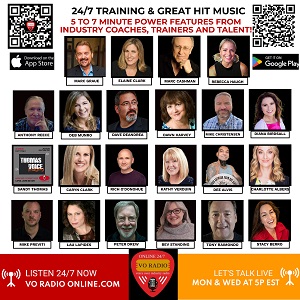|
Acting: Find Your Natural Rhythm
By Peter Drew
Breathe in. Breathe out.
In. Out.
Thankfully, breathing’s an automatic bodily function. But it’s not so automatic when you’re faced with a piece of copy that needs to be voiced. Finding the natural rhythm and breath points in a piece of copy are major keys to a natural sounding read. Ideally, you shouldn’t have to parse copy to find its rhythm. If all copy presented for voice-over was written for the ear, with attention paid to how people naturally speak, then there would be a lot more one-take recording sessions. Since so much copy for voice-over is not written for the ear, it’s a good idea to have an approach to locating its most natural phrasing and breath points. THOUGHT GROUPS In conversation, we speak in "thought groups." Our brains formulate chunks of speech as we think about what we’re trying to say. Research indicates that vocal tics, e.g. “uh,” “um,” “well,” and other short fillers, are simply that - verbal place holders used to buy time for our minds to generate subsequent thoughts and then articulate them. You can use this “thought groups” concept to locate the natural phrasing and breath points in a piece of copy. It can be especially helpful with long-form scripts that contain long technical explanations, scripts that simply may have been lifted from a technical document written for the eye…not the ear. Finding the “thought groups” in a piece of copy that obviously wasn’t written for the ear is not particularly difficult. Just “talk” the copy. In other words, read it in the most conversational manner possible, as if it were coming right off the top of your head. Don’t be concerned with perfect diction or being error-free in your read. NATURAL PAUSES Very often you’ll find yourself pausing in places absent of punctuation, e.g. commas, dashes, periods, etc. Make a slash in pencil at the point of each natural pause. Then go back through the copy again using those slashes as natural breaks or breath points to see if the slashes are in the right places, regardless of how the copywriter punctuated the copy. Again, many copywriters write for the eye not the ear. You’ll find this technique especially helpful in long-form copy, especially medical or scientific scripts, which very often contain long, complex sentences. Talking the copy can help you find breath points in fast-paced hard sell copy, too. This conversational approach can also help you overcome a tendency to “announce” a piece of copy. By talking the copy, you can discover a more natural person-to-person feel for what you’re communicating in the words, instead of primarily worrying about how you sound. Approach copy with an eye and ear toward determining its natural thought groups, and you’ll find your voice-overs will be smoother, with better breath control. Peter Drew, a freelance voice-over talent and copywriter/producer with decades of experience, is heard on radio and television stations, corporate presentations, web sites, and messages-on-hold across America and internationally.
Web: www.peterdrewvo.com
|
|
|
Tell Us What YOU Think!
Please Note: Since we check for spam, there will be a slight delay in the actual posting of your comment.
Comments
No comments have been posted yet. Hurry, and you could be the first!
On Michael Langsner's Voice-Over Roadmap Podcast
Get your bi-weekly dose here ... all things VO!
For essential voice-over business strategies
Inspiring interviews help your VO career
As of the NEW website launch, 03/22/2012

.gif)






.png)
click for new article alerts